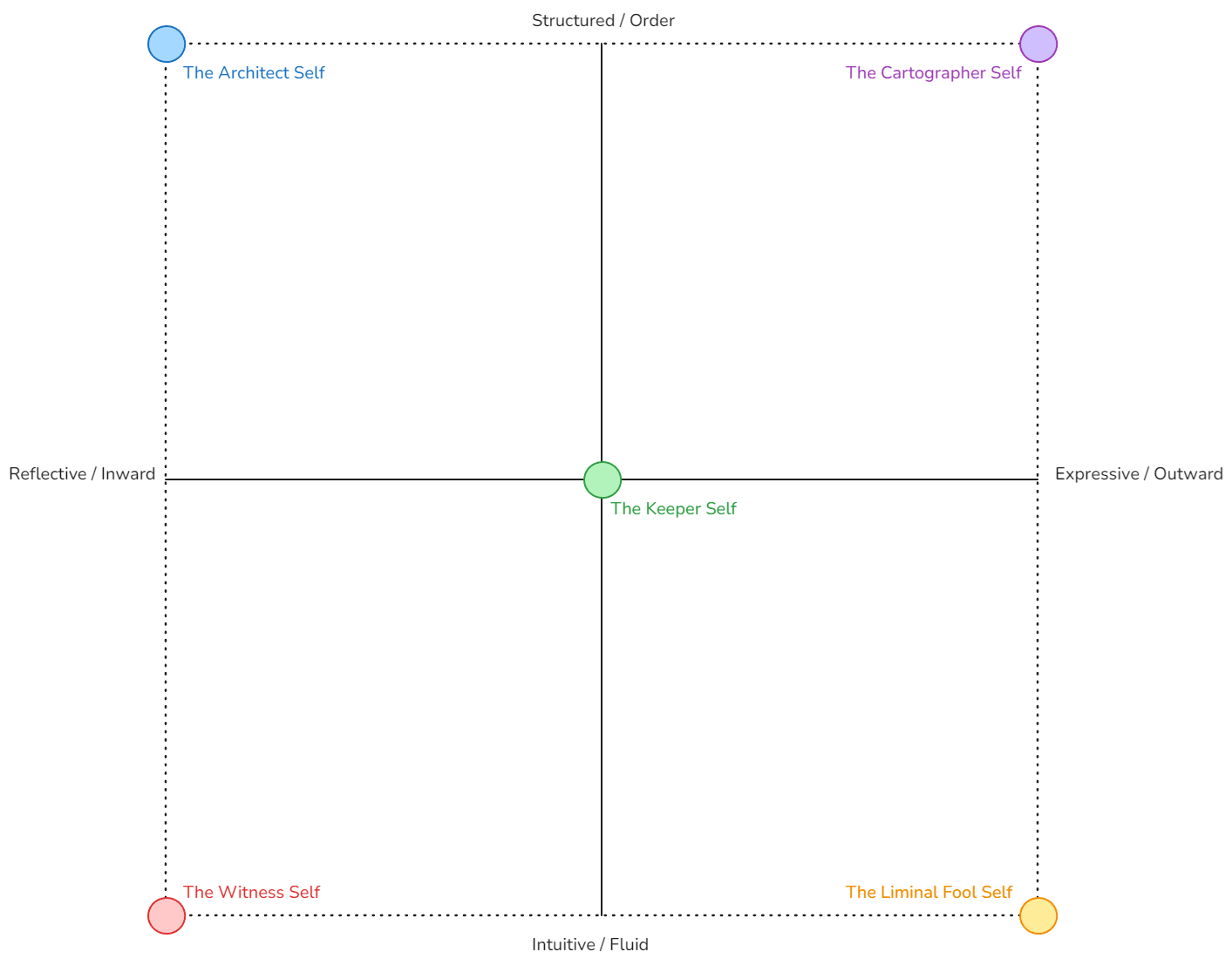This is the symbolic framework of my internal archetypes. Each Self represents a distinct mode of being, thinking, and feeling—mapped along two core axes:
- Reflective ↔ Expressive
- Structured ↔ Intuitive
This system can be used for:
- Journaling & reflection
- Creative planning & character design
- Mood tracking and balance
- Self-invocation rituals
Explanation of the Axes
Axis I: Direction of Energy
The Gaze of the Self
This axis describes where the Self's energy is directed, toward the inner world or outer expression.
| Reflective | Expressive |
|---|---|
| Internal focus, introspection, observation | External focus, action, expression, embodiment |
Reflective
- Attention inward: memory, sensation, intuition, truth
- Asks: “What is true within me?”
- Tends toward contemplation, stillness, self-witnessing
- Danger: Stagnation, passivity, rumination, detachment from others
Not merely hidden, but non-performative. The Reflective Self may express, but does so to understand—not to communicate. Even an outward act (like singing alone) can be Reflective if its purpose is internal coherence.
Defining Question: Would this lose meaning if shared?
Expressive
- Attention outward: gesture, creation, speech, play
- Asks: “What will I say or do?”
- Tends toward communication, improvisation, ritualized expression
- Danger: Disconnection from inner truth, performativity, loss of authenticity
Expression isn’t always social—it is symbolic externalization. Even a whisper, a dance alone, or a silly voice to no one is expression if it lets the inner state take form in the outer world.
Defining Question: Am I allowing what I feel or sense to take form?
Axis II: Cognitive Style
The Shape of Knowing
This axis defines how a Self processes experience, through rules and systems or fluid intuition and association.
| Structured | Intuitive |
|---|---|
| Order, categorization, framework, mapping | Flexibility, symbolism, improvisation, metaphor |
Structured
- Seeks coherence: logic, symbolic design, taxonomy
- Asks: “How does this fit into a framework?”
- Tends toward planning, mapping, system-creation
- Danger: Rigidity, perfectionism, over-definition
Structured cognition isn’t always rational—symbolic structures, emotional maps, and mythic orders count as structure. What matters is the intention to organize meaning, even if the output is poetic.
Defining Question: Am I trying to make sense of something?
Intuitive
- Seeks resonance: sensation, metaphor, ambiguity, association
- Asks: “What does this feel like or remind me of?”
- Tends toward improvisation, poetic logic, symbolic drift
- Danger: Vagueness, dissociation, loss of follow-through
Intuition isn’t “irrational”—it’s nonlinear. It favors mood, memory, pattern, and absurdity. The Fool’s song about a snail and a storm is not nonsense—it is a healing metaphor in motion.
Defining Question: Am I letting go of the need to make sense?
Axis Grid
| Structured (Order) | Intuitive (Fluidity) | |
|---|---|---|
| Outward | The Cartographer Self | The Liminal Fool Self |
| Inward | The Architect Self | The Witness Self |
Center: The Keeper Self
